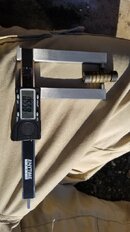Well... somewhat good news. I didn't trust the micrometer so I borrowed a little bit better one (still not professional by any stretch, but it's what a buddy had).
3rd stage piston is right on the money, which means it has a good bit of life left. Probably more then I'll ever need.
The rider rings are a different story. I've tried measuring them multiple times and I either get a little out of spec or right at the lower end of spec. It's definitely time to change them, but now it's a matter of do I put them back in there for another 1000cf or wait until January when parts come in

I almost ordered the parts earlier this year and put it off... all on me.




